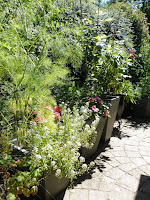 |
| the pastel bed has plenty for the industrious bee |

To help them along most gardeners need to do very little but it is worth bearing in mind that the bees will benefit from a few simple steps (based on RHS guidelines),
~ nectar and pollen rich plants are crucial to support our pollinators, a wide range of plants with different flowering seasons does help
~ avoid using pesticides wherever possible, never spray open flowers. Preventing and reducing pests and diseases by good cultivation, cultivar selection, garden hygiene and using biological control should always be the first line of control. If pesticides are used consider using short persistent organic products. Accepting the presence of some pests can provide larval food for pollinators, for example aphids are food for some hoverfly larvae.
~ provide water for pollinators: Bees and other pollinators sometimes need to drink; having a shallow margin of a pond or a shallow dish filled with stones filled with water will provide a safe source of water.
~ provide nest sites for bees; either make your own or you can purchase nests for solitary bees. Some solitary bees nest in the ground, either in bare soil or short turf but they will find their own nest sites
So my top tip: would be always be mindful of the needs of the bees even if this may compromise just a little on the aesthetics of your outdoorspace









